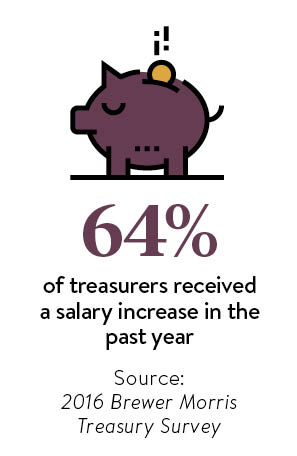Cometh the hour, cometh the hero. When sterling tanked this year, every board of directors in the land swivelled round in desperation to one person – the corporate treasurer. Who else knows about currency hedging and managing cash flow to handle income volatility? Who else can talk to banks about products to steer a balance sheet through troubled times? The treasurer, that’s who.
The treasurer is that sort of role. Respected, always, but a little obscured until moments of drama, when suddenly it’s the role that can save the company.
The traumas of recent years have elevated the position to one of unprecedented prestige. Just look at salaries. The 2016 Brewer Morris Treasury Survey shows pay is soaring, with a fifth of treasurers reporting their pay has risen by more than 20 per cent in the past year. Overall 64 per cent of treasurers received a salary increase in the past year and 79 per cent were handed a bonus. That’s what happens when talent gets recognised.
So, what does the corporate treasurer actually do?
The job role
The diverse duties of the treasurer are what make the job special. The role incorporates cash-flow forecasting, foreign-exchange hedging, forging relationships with banks, investing funds including pensions funds, advising on liquidity, overseeing the extension of credit to customers, and hedging any and all financial risks.
And the role is expanding. Modern treasurers can’t sit in their office any more. They need to march into other departments and sort them out. Rob Barnes, the founder of supply chain finance business PrimeRevenue, which works closely with treasurers, observes: “In previous years the treasury function was siloed. Now treasurers increasingly require a comprehensive understanding of the business, its dynamics and commercial objectives.
A lack of appreciation for the incredible range of duties often leaves treasury departments understaffed and grievously overworked
“Treasurers can use this understanding to provide a number of insights, which can be implemented into a macro view of the business. By understanding the wider commercial business, from procurement, sales and inventory to the board, treasury should be able to offer a strategic insight to the organisation.”
Rising tides of legislation keep increasing the difficulty of the job. Leslie Holstrom, global head of product at EuroFinance, an analyst house that provides research to corporate treasurers, sees this close up. “Treasury is in danger of turning into a compliance department as they grapple with more and more regulatory issues coming at them in markets across the world,” she says.
New tools
A lack of appreciation for the incredible range of duties often leaves treasury departments understaffed and grievously overworked.
Treasurers must master new tools. Data analytics is one of the fastest-moving fields right now. The goal is to harness pools of structured and unstructured data to create actionable insights. It’s currently the domain of data scientists, but the onus is on treasurers to link up with these experts.
There are some great examples already. The Department for Business, Innovation & Skills provides a nice one. The department had its administration budget halved in the drive for austerity. Director general of finance Howard Orme and his team installed data analytics software to examine the performance of the entire operation.
The new system flags up anomalies for the team to check. It tracks activities against public and private-sector benchmarks. And it uses all available data, not just samples as with the old system. The result: cash flow is up, overheads are down and the department has withstood the slashed budget by increasing, not scaling down, its activities.
The future of finance
 The pace of change only increases. The next big leap could be the adoption of blockchain technologies for treasury tasks. Newbies tend to associate blockchain with the notorious cryptocurrency bitcoin. It does indeed run bitcoin payments, but it is so much more than that.
The pace of change only increases. The next big leap could be the adoption of blockchain technologies for treasury tasks. Newbies tend to associate blockchain with the notorious cryptocurrency bitcoin. It does indeed run bitcoin payments, but it is so much more than that.
The blockchain is a method of recording transactions of any kind. In essence it’s an open ledger, which anyone can read. All market participants possess a copy, if they wish. And every single transaction is recorded in each copy of the ledger, simultaneously.
The variety of uses is startling. The Bank of England held a competition for the most imaginative use of blockchain. The winner was a team from the University of Edinburgh who developed a system for tracking blood in the NHS. Honduras is looking at moving property transactions to a blockchain ledger. The Nasdaq stock market is experimenting with share issuance using the technology. Blockchains may change the way treasurers write contracts, how they handle cash and authorise payments.
The value of investing in the sector underscores the hype. Juniper Research estimates $300 million of venture-capital cash went into blockchain startups in the first half of this year. One of the recent big deals was a $55-million series B investment in Ripple Labs, which created the Ripple payment system that bypasses banks. Blockchain could be one of the biggest changes to hit finance departments since the internet.
It’s a daunting job description. A top-class treasurer must be superlative with numbers, a negotiator, forecaster, risk manager and sensitive enough to gather the support of colleagues in different roles, many of whom won’t have the slightest appreciation of what the treasurer is trying to achieve. Boards know the value of the role. It’s about time the rest of us did.
The job role
New tools
The future of finance

